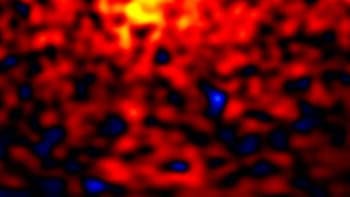
The Fermi Gamma-ray Space Telescope could detect the telltale signs of dark-matter annihilation in as little as a year, if calculations by UK and US astrophysicists prove correct.
The calculations, which are the first to take into account the relative velocities of dark-matter particles, suggest that dark-matter annihilation is many times more prevalent than has been predicted before. If this is true, the annihilations could be producing enough gamma rays to expose several clumps or “subhaloes” of dark matter in Fermi’s first year of data collection alone.
Michael Kuhlen, lead author of the research and an astrophysicist at the Institute for Advanced Study in Princeton, US, says such a detection by Fermi would be “an amazing confirmation” of the standard paradigm of structure formation in “cold” dark-matter theories. “First of all, it would show that dark matter is cold, and that it forms small clumps that populate the Milky Way,” he says. “Second of all, it would show that it is a fundamental particle, which is still not really
Confirming theory
Cold dark matter has become the most accepted explanation as to why the universe appears to have at least 80% more gravitating mass than is directly visible to telescopes. According to theory, cold dark matter is not luminous and interacts only via gravity, and exists in vast haloes around the centres of galaxies. These haloes are full of lumpy substructures called subhaloes, which would be the most likely places for dark-matter particles to collide with one another and annihilate.
Past simulations of dark matter for a galaxy like our own Milky Way have always predicted annihilations to be so rare that telescopes would barely be able to detect the resultant gamma-rays and other particles above the universe’s background. Last year, however, the European satellite PAMELA and the international balloon-borne experiment ATIC recorded excesses of positrons and electrons respectively, hinting at dark-matter annihilation.
Kuhlen, together with Piero Madau at the University of California in Santa Cruz, US, and Joseph Silk at the University of Oxford, UK, decided to see whether these observations could be explained if dark-matter annihilation rates were boosted by an effect known as the Sommerfield enhancement. In this effect, a long range force — which would manifest as either a conventional weak-force boson or a new force carrier — increases the rate of annihilations when the dark-matter particles are moving slowly. Kuhlen’s group applied several different models of Sommerfield enhancement to a simulation of the Milky Way that contained more than a billion particles to see how the gamma-ray flux would be affected.
Seeing subhaloes
For the greatest enhancement, the researchers found that more than 400 subhaloes would be detectable to the Fermi space telescope — which was launched in June 2008 — after one year, and after ten years the figure would rise to over 900. But even for the most conservative model, the researchers found that after a year five subhaloes would be visible.
The news is likely to excite astrophysicists, many of whom have spent decades searching for dark matter’s smoking gun.
“The indirect search for dark matter through its signature in gamma rays is one of the central topics in the Fermi science programme,” says Ronaldo Bellazzini, a physicist at the University of Pisa, Italy, and principal investigator of Fermi’s Italian team. Bellazzini explains that Fermi could detect gamma rays from annihilation even without effects such as the Sommerfield enhancement, but that the latter will improve the chances. “We have already started a search for a dark-matter signal in candidate subhaloes,” he says, adding: “No dark-matter [signal] has been found in the three months of data. This is not yet in contradiction with the most conservative predictions of this paper.”
This research appears in the latest edition of Science.



